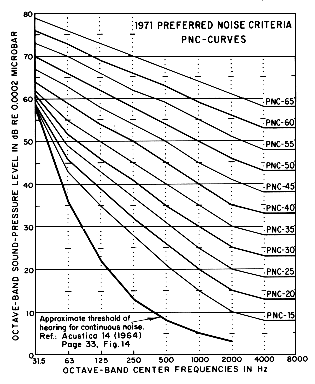NOISE
CRITERION (NC)
A noise rating system introduced by Leo Beranek
in 1957 to take into account the distribution of noise energy in
various frequency bands. It has since been superseded by the
NOISE
RATING method which functions on similar
principles. A comparison of acceptable levels for residential
bedrooms would be NC 25 - 35 and NR 25. Both of these are in the
range of 30 dBA. The original noise criterion curves applied to
continuous sounds in indoor environments, and took speech
communication into consideration.
In 1971, Preferred Noise Criterion
curves (PNC) were published, in which allowable levels for low and
high frequency noise were lowered. The new PNC curves apply to
steady AMBIENT NOISE
LEVELs in enclosed spaces, and are often used
to judge the acceptability of ventilation and other background
BROAD BAND
NOISE.
See also: INFRASONIC,
MASKING. Compare:
SPEECH
COMMUNICATION CRITERION, SPEECH
INTERFERENCE LEVEL.
Representative recommended PNC levels and their
dBA equivalents (see SOUND
LEVEL, SOUND LEVEL
METER) are:
|
|
PNC
|
dBA
|
|
Excellent listening conditions
|
less than 20
|
less than 30
|
|
Sleeping, residential, private office, library &
classroom spaces
|
25 - 40
|
34 - 47
|
|
Large offices, stores, cafeterias and restaurants
|
35 - 45
|
42 - 52
|
|
Lobbies, laboratory, engineering and secretarial
spaces
|
40 - 50
|
47 - 56
|
|
Maintenance, equipment, kitchen and laundry rooms
|
45 - 55
|
52 - 61
|
|
Shops, garages, power-plant control rooms, etc.
|
50 - 60
|
56 - 66
|
From the table and curves, it can be seen that
the equivalent allowed noise levels rise with lower frequencies.
This can in part be attributed to the ear's decreasing sensitivity
to low frequency sound (see EQUAL
LOUDNESS CONTOURS). However, these levels
allow exposure to very low frequency and INFRASONIC
vibration, which have been shown to be the cause of various
physical and psychological disorders.
As a verification of their criteria, the
authors report that measurements in auditoria and offices which
the occupants find satisfactory fall in the appropriate PNC
range. Being generally inaudible, infrasonic vibrations are not
likely to provoke conscious awareness, despite their ability to
cause involuntary physiological effects. Therefore, PNC-type
criteria provide no protection for low frequency sound exposure,
and further, tend to rely on the public's increasing toleration of
background noise and what seems to be decreasing auditory skills.
Compare: SOUND
INTRUSION, SOUND
POLLUTION.
